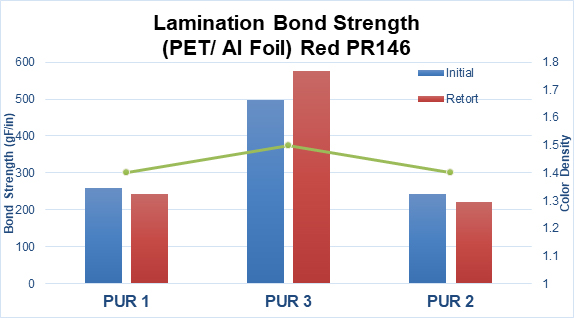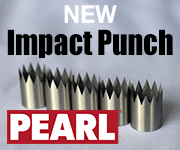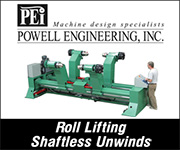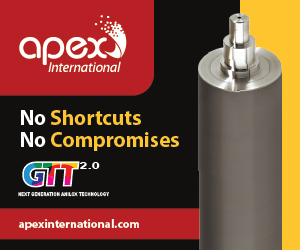Featured Stories
-
Elevating Pouch Manufacturing with Pearl Technologies' Cutting-Edge Solutions
For manufacturers seeking efficiency, precision, and safety in pouch production, Pearl delivers unmatched innovation across three standout... -
Faster Product Composition Analysis Equals Better Quality Assurance
Near Instant Testing and Reduced Costs to be Found -
Methods to Precisely Measure Tension and Web Control
How to Control Automatically Within Set Parameters
News | New Products
-
PACKZ 11 Launches with Industry-First RIP Integration
Plus extended CF2 format and automated support for 2-D Barcodes as Required by the Sunrise 2027 Initiative
-
Double E Group Acquires CAC, Further Enhancing its Strength in the Global Converting Industry
Double E Group, a global leader in converting components and web handling technology, has announced its acquisition of Converter Accessory Corporation (CAC)
-
Nobelus Launches Entry-Level Komfi® Thermal Laminator
FINISHING SOLUTIONS SUPPLIER OFFERS NEW JUNIOR 52 LAMINATING SYSTEM
-
Double E Group Mourns the Loss of Founder and Converting Industry Pioneer, Richard Edward Flagg
Double E Group announces with profound sadness the passing of its founder, Richard Edward “Ed” Flagg, on June 23, 2025. He was 85.
-
Convertech Brand to Fully Transition to Double E Group Same Team, Same Excellence, Unified Name
Double E Group has announced that Convertech, one of its subsidiaries and a trusted provider of core chucks and shaft solutions for the converting industry, will now operate solely under the Double E Group brand.
-
Pulse is Making Print Simple at Labelexpo Europe 2025
Narrow web ink specialist Pulse is Making Print Simple at Labelexpo Europe 2025, as it challenges flexo printers to rethink how they work and shows solutions that turn production bottlenecks into revenue generators.
-
ROTOCON to debut at Labelexpo Europe with three machine demonstrations
ROTOCON will make its Labelexpo Europe debut, exhibiting together with HS Machinery on stand 4D21.
Expert Advice
Polyurethane Ink Resins for Flexible Packaging – Current and Future Needs
- Published: April 02, 2019
By Suhas Chavannavar, Market Segment Manager for Flexible Packaging Ink Resins and Digital Printing at BASF Corporation.
The flexible packaging segment is the second largest packaging segment (19 percent) in the U.S. behind corrugated paper (24 percent) but ahead of rigid plastics (15 percent)1. The major end-use application for flexible packaging is food packaging, comprising of more than half of the entire segment. The food packaging segment can only be expected to rise as more food categories and brand owners, currently employing glass, metal or rigid plastics, transition to the flexible packaging format.
The rising popularity of the flexible packaging format has to do with its numerous benefits over the existing alternatives. The benefits they provide include improved shelf life, lower transportation costs, reduced material consumption and landfill contribution. This format is cost effective and offers a great marketing opportunity with the ability to print on flexible packaging substrates. Enabling these benefits are continual improvements in substrate, ink, printing and converting technology. An often-overlooked area is the resins that go in to the inks. Not only do they make the graphics and packaging more attractive, they also provide functional benefits.
There are many different types of resins that go into inks used for printing on flexible packaging – styrene acrylics, polyurethanes, polyamides, nitrocellulose etc. However, strong growth in categories such as snack foods, pre-cooked meals, meat, cheese and poultry necessitate multi-laminate packaging structures. Such packaging incorporates reverse printing on the outer layer of packaging and laminating to an internal layer. The unique requirements and challenges of such packaging bring polyurethane resin-based ink systems to the forefront.
While polyurethane resins create a flexible film and provide superior lamination bond strengths – that prevent delamination of the packaging – they are not as effective as other resins when it comes to pigment dispersion and they also tend to be harder to print with. For this reason, PURs tend to require a co-resin to help improve the pigment dispersion.
With strong growth in food categories that require laminated packages, PURs will be required to disperse pigments more efficiently, print better and keep costs and complexity down. With retort and other medium performance multi-laminate packaging structures poised for growth, there is a need for high bond strengths under challenging conditions. Furthermore, addition of nitrocellulose to disperse pigments may not always be an option. Exposure of nitrocellulose in the packaging to high temperatures during the retort process can lead to formation of nitrosamines which is undesirable.
As a printer or convertor, one needs to carefully consider the ink being used in such packaging applications. Not all PURs are similar in performance. Ink formulators incorporate specific PURs in their formulations to impart specific performance characteristics to the ink. For instance, when considering a PUR for retort or higher performance lamination packaging applications such as those employed for meat, cheese and poultry packaging, consideration should be given to the required bond strengths and ability to grind pigment without nitrocellulose. Another important consideration, and this is mostly true regardless of the packaging application, is the printability of the PUR based ink. Sometimes tradeoffs between bond strengths and printability do need to be made. The accompanying charts in Fig. 1 illustrate the performance characteristics of three PURs currently on the market for high performance and retort packaging applications.


Fig 1: Performance characteristics of PURs intended for high performance packaging applications
The requirements for PURs are different in less demanding packaging applications such as confectionary and condiments or even standard performance lamination packaging applications such as snack bags. The prime considerations for a PUR used in such packaging applications are compatibility with nitrocellulose, bond strengths and cost of the resin. Compatibility with nitrocellulose is key because of its widespread use. It has great pigment grinding ability and is widely used, but it doesn’t have the flexibility and adhesion of PURs. PURs for such applications don’t require the high bond strengths required in medium and high-performance packaging applications. Oftentimes these PURs are also used for surface print applications where they are required to provide resistance properties and adhesion to the substrate..
Regardless of the packaging application, when it comes to white inks, the ability to achieve maximum opacity and bond strengths is crucial. Addition of other resins can lower bond strengths and opacity. As a result, a PUR with the ability to grind the inorganic pigment without another resin, such as nitrocellulose or polyvinyl butyral, helps achieve both, higher bond strengths and higher opacity.
As the printing and packaging industry evolves, new requirements and challenges will arise and PUR technology will need to evolve too. Two key trends that will influence the adoption of PURs are increased use of solventless adhesives in the lamination process and the emergence of high speed presses. Solventless adhesives used in the lamination process help eliminate VOC emissions and don’t require energy to dry unlike solvent-based adhesive laminations. However, the chemistry of the solventless adhesives introduces the challenge of smearing the print. PURs that provide greater resistance to solventless adhesives will make for a more robust ink system.
The other key trend is the emergence of high speed printing presses capable of printing at speeds greater than 2000 feet per minute. It is common knowledge that while PURs provide numerous benefits, they are also prone to stringing or cobwebbing at high speeds. As printers who have invested heavily in high speed presses look to extract their ROI, PURs will need to be able to print at progressively higher speeds.
Other improvements that can be expected in the future are PURs that provide enhanced pigment grind ability, especially with organic pigments.
There is no denying that the use of PURs is only going to increase with the growth in flexible packaging being driven by certain food categories. The extent of adoption, however, is dependent on the ability of PURs to enable this transition.
References
- State of the U.S. Flexible Packaging Industry Report 2018, Flexible Packaging Association
About the Author
Suhas Chavannavar is the market segment manager for flexible packaging ink resins and digital printing at BASF Corporation. He is responsible for shaping the segments’ strategy and leading marketing plans. He earned a bachelor’s degree in chemical engineering and his MBA from University of North Carolina – Chapel Hill.






















